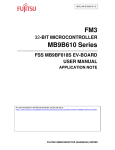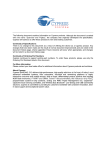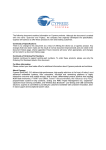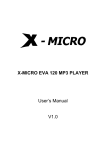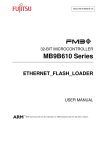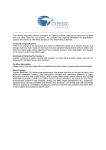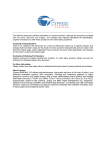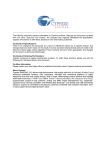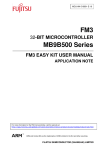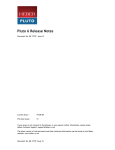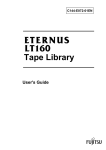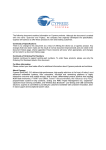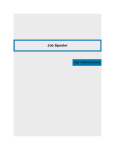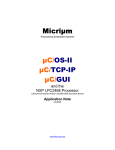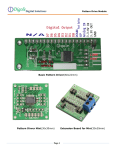Download Application Note
Transcript
The following document contains information on Cypress products. Colophon The products described in this document are designed, developed and manufactured as contemplated for general use, including without limitation, ordinary industrial use, general office use, personal use, and household use, but are not designed, developed and manufactured as contemplated (1) for any use that includes fatal risks or dangers that, unless extremely high safety is secured, could have a serious effect to the public, and could lead directly to death, personal injury, severe physical damage or other loss (i.e., nuclear reaction control in nuclear facility, aircraft flight control, air traffic control, mass transport control, medical life support system, missile launch control in weapon system), or (2) for any use where chance of failure is intolerable (i.e., submersible repeater and artificial satellite). Please note that Spansion will not be liable to you and/or any third party for any claims or damages arising in connection with above-mentioned uses of the products. Any semiconductor devices have an inherent chance of failure. You must protect against injury, damage or loss from such failures by incorporating safety design measures into your facility and equipment such as redundancy, fire protection, and prevention of over-current levels and other abnormal operating conditions. If any products described in this document represent goods or technologies subject to certain restrictions on export under the Foreign Exchange and Foreign Trade Law of Japan, the US Export Administration Regulations or the applicable laws of any other country, the prior authorization by the respective government entity will be required for export of those products. Trademarks and Notice The contents of this document are subject to change without notice. This document may contain information on a Spansion product under development by Spansion. Spansion reserves the right to change or discontinue work on any product without notice. The information in this document is provided as is without warranty or guarantee of any kind as to its accuracy, completeness, operability, fitness for particular purpose, merchantability, non-infringement of third-party rights, or any other warranty, express, implied, or statutory. Spansion assumes no liability for any damages of any kind arising out of the use of the information in this document. ® ® ® TM Copyright © 2013 Spansion Inc. All rights reserved. Spansion , the Spansion logo, MirrorBit , MirrorBit Eclipse , TM ORNAND and combinations thereof, are trademarks and registered trademarks of Spansion LLC in the United States and other countries. Other names used are for informational purposes only and may be trademarks of their respective owners. MCU-AN-510044-E-10 FM3 32-BIT MICROCONTROLLER MB9B610 Series FSS MB9BF618S EV-BOARD USER MANUAL APPLICATION NOTE For more information for the FM3 microcontroller, visit the web site at: http://www.fujitsu.com/global/services/microelectronics/product/micom/roadmap/industrial/fm3/ FUJITSU SEMICONDUCTOR (SHANGHAI) LIMITED ARM and Cortex-M3 are the trademarks of ARM Limited in the EU and other countries. ALL RIGHTS RESERVED The contents of this document are subject to change without notice. Customers are advised to consult with sales representatives before ordering. The information, such as descriptions of function and application circuit examples, in this document are presented solely for the purpose of reference to show examples of operations and uses of FUJITSU SEMICONDUCTOR device; FUJITSU SEMICONDUCTOR does not warrant proper operation of the device with respect to use based on such information. When you develop equipment incorporating the device based on such information, you must assume any responsibility arising out of such use of the information. FUJITSU SEMICONDUCTOR assumes no liability for any damages whatsoever arising out of the use of the information. Any information in this document, including descriptions of function and schematic diagrams, shall not be construed as license of the use or exercise of any intellectual property right, such as patent right or copyright, or any other right of FUJITSU SEMICONDUCTOR or any third party or does FUJITSU SEMICONDUCTOR warrant non-infringement of any third-party's intellectual property right or other right by using such information. FUJITSU SEMICONDUCTOR assumes no liability for any infringement of the intellectual property rights or other rights of third parties which would result from the use of information contained herein. The products described in this document are designed, developed and manufactured as contemplated for general use, including without limitation, ordinary industrial use, general office use, personal use, and household use, but are not designed, developed and manufactured as contemplated (1) for use accompanying fatal risks or dangers that, unless extremely high safety is secured, could have a serious effect to the public, and could lead directly to death, personal injury, severe physical damage or other loss (i.e., nuclear reaction control in nuclear facility, aircraft flight control, air traffic control, mass transport control, medical life support system, missile launch control in weapon system), or (2) for use requiring extremely high reliability (i.e., submersible repeater and artificial satellite). Please note that FUJITSU SEMICONDUCTOR will not be liable against you and/or any third party for any claims or damages arising in connection with above-mentioned uses of the products. Please note that FUJITSU SEMICONDUCTOR will not be liable against you and/or any third party for any claims or damages arising in connection with above-mentioned uses of the products. Any semiconductor devices have an inherent chance of failure. You must protect against injury, damage or loss from such failures by incorporating safety design measures into your facility and equipment such as redundancy, fire protection, and prevention of over-current levels and other abnormal operating conditions. Exportation/release of any products described in this document may require necessary procedures in accordance with the regulations of the Foreign Exchange and Foreign Trade Control Law of Japan and/or US export control laws. The company names and brand names herein are the trademarks or registered trademarks of their respective owners. Copyright ©2010 FUJITSU SEMICONDUCTOR (SHANGHAI) LIMITED All rights reserved. 2 Revision History Date 2012-05-28 Author FSS Version V1.0 Remark 3 Table of Contents REVISION HISTORY ................................................................................................. 3 1 INTRODUCTION ................................................................................................... 5 1.1 Product Overview ....................................................................................................... 5 1.2 MB9B610 Series MCU................................................................................................ 5 1.3 Board Features ........................................................................................................... 6 2 GETTING STARTED ............................................................................................. 7 2.1 UART ...................................................................................................................... 7 2.2 Joystick ................................................................................................................... 8 2.3 Nand flash ............................................................................................................... 8 2.4 Micro SD ................................................................................................................. 8 2.5 USB host ................................................................................................................. 8 2.6 Ethernet .................................................................................................................. 9 3 HARDWARE SETTING ....................................................................................... 11 3.1 Connectors Overview ............................................................................................ 11 3.2 Setting for USB On-Board Programming ............................................................... 11 3.3 Setting for Debug Tool........................................................................................... 11 4 FLASH ON-BOARD PROGRAMMING ............................................................... 12 4.1 On-Board Programming via USB ........................................................................... 12 5 SAMPLE CODE ................................................................................................... 14 6 DEBUG TOOL AND IDE...................................................................................... 16 7 MATERIALS TO DOWNLOAD ............................................................................ 17 4 1 Introduction 1.1 Product Overview FSS MB9BF618S Evaluation Board (PN: FSSDC-9B618-EVB, shown as below) provides an economical and simple means for the study of MB9BF610 series MCU (ARM cortex-M3 based). The board contains dual Ethernet ports and some external resources (LED, Key, USB Device, USB Host interface, NAND Flash and Micro SD) to demonstrate MCU periphery function. It also provides standard 20 pin JTAG interface, which is compatible with both IAR and Keil debug tool. In addition, it allows on-board programming using USB mode. Figure 1-1: FSSDC-9B618-EVB Overview 1.2 MB9B610 Series MCU MB9B610 series MCU is 32-bit general purpose MCU of FM3 family that features the industry's leading-edge ARM Cortex-M3 CPU and integrates Fujitsu's highly reliable and high-speed secure embedded flash technology. And up to 2 independent Ethernet MAC controllers are contained in the MCU. This MCU can operate at up to 144MHz CPU frequency and work at a wide voltage range (2.7V-5.5V), which can be compatible with both 3.3V and 5V system. It includes a host of robust peripheral features, including motor control timers (MFT), base timer (can be configured to PWM, PPG, Reload, PWC timer), ADCs, on-chip memory (up to 1M bytes Flash, up to 128K bytes SRAM) and a wide range of communication interfaces (USB, I2C, SIO, LIN, CAN). The size of on-chip memory varies with different part number and the package is available in LQFP and BGA, as shown in following table. 5 Product MB9BF616S/T Flash 512kB SRAM 64kB Package S: LQFP: FPT-144P-M08 (0.5mm pitch) MB9BF617S/T 784kB 96kB MB9BF618S/T 1MB 128kB T: LQFP:FPT-176P-M07(0.5mm pitch) BGA: BGA-192P-M06 (0.8mm pitch) Table 1-1: Product List 1.3 Board Features FSSDC-9B618-EVB includes following features: Microcontroller MB9BF618S 2x Ethernet Ports 1x USB-Host (Type-A connector) 1x USB-Device (Type-B connector) 1x UART 1x LED (for user) ,1x LED (for power) 1x Joystick 1x ‘Reset’-button 1x Nand Flash(32MBytes) 1 xMicro SD slot (SPI) Standard JTAG Interface on a 20 pin-header Power supply via USB-Device, JTAG or external with 15V DC power 6 2 Getting Started The microcontroller on the FSSDC-9B618-EVB has been programmed with a test program. Please follow the steps below firstly. 1) Make sure that both JP11 and JP5 are shorted, MD0 is disconnected. Connect the EVB with PC via USB cable (Type-B Connector) for power supply. 2) Observe blinking of the LED (Green), which shows that both the test program in the MCU and the power supply work well. 2.1 UART Connect the EVB with serial COM of PC (using extension cable). A USB-232 cable is the alternative if serial COM is not available for the PC. Run the serial tool on the PC and set its parameters. The configuration below is for super terminal of the Windows: 8-bits data, 1 stop bit, no parity, 115200 bps baudrate. Figure 2-1: Configuration of serial communication The message below will be shown in the serial debug tool after the EVB is powered on. MB9B618EVB test items 1 Joystick 2 Nand Flash 3 SD card 4 USB host Figure 2-2: start-up message of the EVB The message indicates that the UART can receive data successfully and the test can be continued. 7 2.2 Joystick Input “1” into the sending out area of the serial tool and then press the button “手动发送” to send command to the EVB The message of “ joystick testing, press enter key to exit ” will be shown in the tool as figure 2-3 The corresponding name of the key will be shown on the tool when it is pressed Press the middle key ” enter ” to exit the testing of joystick The message of ” exit joystick test ” will be shown thereafter Figure 2-3: testing screen 2.3 Nand flash Input “ 2 “ into the same tool and press ” 手动发送 ” button to send it out The message of ” Nand testing ” will be shown The message of ” Nand is OK ” will be shown if the Nand flash works well The message of ” Nand Error” will be shown if error presents in the connection between Nand flash and MCU. 2.4 Micro SD Input “ 3 “ into the same tool and press ” 手动发送 ” button to send it out The message of ” SD testing ” will be shown The message of ” SD is OK ” will be shown if the SD works well The message of ” SD Error ” will be shown if SD is not plugged 2.5 USB host Input “ 4 “ into the same tool and press ” 手动发送 ” button to send it out 8 Plug flash disk into the EVB. The message of ” Udisk Attached! ” will be shown when the flash disk is recognized by the USB host dirver The message of ” Udisk Detached! ” will be shown when the flash disk is unplugged The message of ” Exit USB host test” will be shown when pressing the “enter ” key to exit the testing of USB host 2.6 Ethernet Set the IP address of PC as shown below: Figure 2-4: IP address setting of PC Figure 2-5: IP address of PC after configured Short JP11.Connect the PC and Ethernet Port 0 (J1) with an Ethernet cable The green light of the Ethernet port should be illuminated when EVB powers on 9 Ping testing---Send command of “ping 192.168.1.20 “ per CMD.exe tool of PC The screen below should be shown when the Port 0 is connected and works well Figure 2-6: Ethernet Port0 testing Connect the PC and the Ethernet Port 1 (J2) with an Ethernet cable. Ping testing---Send command of “ping 192.168.2.22 “ per CMD.exe tool of PC The screen below should be shown when the Port 1 is connected and works well Figure 2-7: Ethernet Port1 testing 10 3 Hardware Setting 3.1 Connectors Overview Connector Funcion JP5~JP7 Power selection MD0 Mode setting JP9 USB programming PHY reference clock selection Testing / extenstion pins JP10,JP11 J9,J20,J21 Setting Short JP5: power by USB Short JP6: power by JTAG Short JP7: power by external power supply Short: Programming mode, JP9 should be shorted also Open: Normal mode Work with MD0 to update the internal Flash of MCU Short JP10: 50Mhz provided by MCU Short JP11: 50Mhz provided by external oscillator Table 3-1: Connector List Attention: 1) Never short JP5-JP7 at the same time! When Keil U-Link ME is used, power supply by JTAG is not supported. 2) Never short JP10 and JP11 at the same time, which will cause abnormity of the MCU! 3.2 Setting for USB On-Board Programming Connector Function Setting MD0 Mode setting short JP9 USB programming short Table 3-2: Setting for USB On-Board Programming 3.3 Setting for Debug Tool Using IAR J-Link Connector J14 Function JTAG connector JP5~JP7 Power selection MD0 Mode setting Setting Connected with J-Link Short JP5: power by USB Short JP6: power by JTAG Short JP7: power by external power supply Open Table 3-3: Setting for J-Link Using Keil U-Link ME Connector Function Setting J14 JTAG connector Connected with J-Link JP5,JP7 Power selection Short JP5: power by USB Short JP7: power by external power supply MD0 Mode setting Open Table 3-4: Setting for U-Link Me 11 4 Flash On-Board Programming 4.1 On-Board Programming via USB Check the connector setting as described in section 3.2. When connecting with PC via USB cable, the EVB can be identified as a USB device after power on. Figure 4-1: USB Device Sign Check the COM port for this USB device in the device manager. Figure 4-2: COM Port in Device Manager Install the USB programmer: usbdirect-v01l05.zip. (It can be downloaded from the web) Run the software and set the parameter as shown in following figures, and select Hex file. Click “Full Operation” button. Figure 4-3: Setting of USB Programmer 12 Figure 4-4: Reset the EVB message during programming Reset the EVB and click the “OK” button to start programming. Figure 4-5: Programming complete successfully 13 5 Sample Code The following sample projects are provided for FSSDC-9B618-EVB. Please check the update of the website for more samples. Project Name Description 618EVB_sample Developed using IAR IDE, the simple demo of accessing the peripherals on the EVB is provided, such as USB host, UART, Micro SD, Nand flash, Joystick and Led. 618EVB_ethernet Developed using IAR IDE, uC/OS-II and an open source TCP/IP stack—LwIP are adopted to demonstrate the Ethernet features of the MB9BF618S. Some sample applications are provided, i.e. UDP/TCP server & Web server. mb9bf618s_template The project template for IDE of IAR and Keil. Notes: 1) More details for the Ethernet demo projects can be found in another user manual with PN: MCU-AN-510042-E-10. 2) The source code of uC/OS-II kernel should be downloaded from the web below and copied to folder of : middleware\uCOS_II_V286\Source\ http://micrium.com/page/downloads/source_code Figure 5-1: Structure of the Project folder 14 3) IAR IDE version is EWARM V6.21 and Keil IDE version is uVision 4.21. 4) If using other version IDE to debug these projects, compiling error may occur. Then please kindly check the following settings. IAR IDE MCU type Pre-included file ICF file Flash loader Keil IDE MCU type Pre-included file ROM & RAM memory address 15 6 Debug Tool and IDE FSSDC-9B618-EVB supports both Keil U-Link-ME and IAR J-Link for debugging. Figure 6-1: J-Link Overview Figure 6-2: U-Link Me Overview The U-Link-me should be used with Keil uVision 4 which can be downloaded freely from following website. https://www.keil.com/update/sw/RVMDK/4.21 The J-Link should be used with IAR Embedded Workbench which can be downloaded freely from following website. http://www.iar.com/website1/1.0.1.0/68/1/ The introduction of using the IDE can be found in the document whose PN is MCU-AN510014-C-10. 16 7 Materials to Download The following materials can be downloaded from the website, http://www.fujitsu.com/cn/fss/mcu/32bit/fm3/ Software FUJITSU Flash USB DIRECT Programmer Document FSSDC-9B618-EVB User Manual FSSDC-9B618-EVB Schematic MB9B610 Series Datasheet MB9B610 Series Peripheral Manual MB9B610 Series Flash Programming Manual Sample code 618EVB_sample 618EVB_ethernet mb9bf618s_template IDE Study Material IAR IDE study material Keil IDE study material 17



















